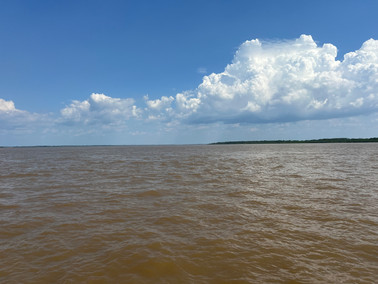After talking with my new friend, Francois, about their travels, I decided to head to Manaus to see about a river trip up the Rio Negro on a his friend, Marcelo's, boat. Francois is passionate about indigenous people, and the boat visits indigenous villages to distribute medicines, solar panels, and other helpful items, often with volunteer doctors and dentists.
You know, it was only a few inches on the map of Brazil. I knew it was going to take a few days. but what I didn't expect is how tiring and uninteresting most of the drive would be. It took four long days, 11-12 hours per day (except the last day). First day was from Pacchata in the mountains southeast of Cusco past Puerto Maldanado to about an hour from the Brazilian border. I slept at a rest area. The second day was across the Brazilian state of Acre (north of Bolivia) to about an hour from Porto Velho. I slept on a bluff above a river at Jaci Parana. The third day was to a point on the road to Manaus from Humaita (BR-319). There I slept in the pitch-black jungle with all the jungle night sounds. The fourth day was to Manaus.
What I didn't know beforehand was that I would mostly see cut-over deforested lands with large cattle ranches. It was sad. I kept telling myself that people need to make a living. But at what cost? To the environment? To the climate (the Amazon produces 20% of the Earth's oxygen)? And at what costs to human life and diversity? After arriving in Manaus, I read online how cattle ranchers, loggers, and gold miners moved in to indigenous territories, which led to the extinction of tribes from introduced diseases and outright genocide. After reading about indigeous peoples of northern Brazil and the Amazon, I thought back to a book I read in 6th grade, Ishi, Last of His Tribe, about a lone man who wandered out of the wilderness in northern California in the early 20th century after all of his family and others in his band had died. It also reminded me of the genocide of California Indians in which gold miners and ranchers in the mid-19th century just shot Indians as they encountered them. But this here in Brazil was more than a hundred years later.
The road from Humaita to Manaus was very tiring and dusty (it's the dry season). As I passed large trucks, sometimes it was so dusty I could not see 20 m ahead of me. And rough. Hank and I were pretty well rattled. As I was falling asleep, I was so tired and hungry, and a bit sad and lonely. I missed Sheri. But I was also glad she wasn't with me since she would not have enjoyed the long drives. It was so dark. I started to have empathy for Henry when he gets scared of the dark.
I had to take a couple ferries on the way. The first one was a short ferry across a small river. I made friends with several Brazilian motorcyclists who were doing a loop to Manaus, downriver on some barges, then back south. The second ferry was across the Amazon and Rio Negro rivers. Wow: that's a lot of water heading to the distant Atlantic Ocean, and at only 92 m above sea level (120 ft). Twenty percent of the Earth's freshwater flows down the Amazon into the Atlantic.
Although it was a long and tiring drive, still it was definitely worth it. I got to see a cross-section of Brazil and I got to learn about the landscapes, history, and culture of a part of the Amazon Basin.
"Travel isn't always pretty. It isn't always comfortable. Sometimes it hurts, it even breaks your heart. But that's OK. The journey changes you; it should change you. It leaves marks on your memory, on your consciousness, on your heart, and on your body. You take something with you. Hopefully, you leave something good behind." -- Anthony Bourdain




































Comments